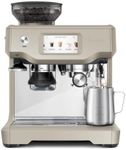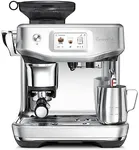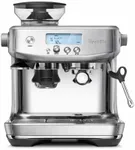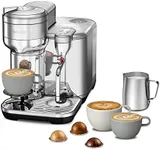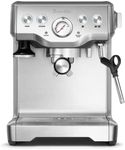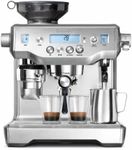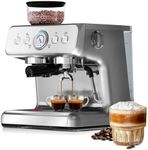Buying Guide for the Best Breville Espresso Machines
Choosing the right espresso machine can make a big difference in your daily coffee experience. When shopping for an espresso machine, it's important to think about how involved you want to be in the coffee-making process, how much space you have in your kitchen, and how many people will be using the machine. Understanding the key features will help you find a machine that matches your needs and makes your coffee routine enjoyable and easy.Type of Machine (Manual, Semi-Automatic, Automatic, Super-Automatic)The type of espresso machine refers to how much control you have over the brewing process. Manual machines require you to do everything yourself, from grinding the beans to controlling the water flow, which is great for enthusiasts who want to perfect their technique. Semi-automatic machines automate some steps but still let you control the shot timing, making them a good balance for most home users. Automatic machines handle more of the process, including shot timing, which is convenient if you want consistency without much effort. Super-automatic machines do almost everything at the touch of a button, including grinding, tamping, and brewing, which is ideal for those who want speed and simplicity. Think about how hands-on you want to be and how much time you want to spend making coffee to decide which type suits you best.
Boiler Type (Single, Dual, Heat Exchange)The boiler type affects how quickly and efficiently the machine can brew espresso and steam milk. Single boiler machines can only do one task at a time—either brew or steam—so you have to wait between steps, which is fine for occasional use. Dual boiler machines can brew and steam simultaneously, making them great for making multiple drinks quickly or for those who love milk-based drinks. Heat exchange machines use a single boiler but can still brew and steam at the same time, offering a good compromise. If you often make drinks for several people or enjoy lattes and cappuccinos, a dual boiler or heat exchange system will save you time and effort.
Grinder IntegrationSome espresso machines come with a built-in grinder, while others require a separate grinder. Having a built-in grinder saves space and makes the process more convenient, especially if you want an all-in-one solution. However, separate grinders often offer more control over grind size, which can improve the quality of your espresso. If you value convenience and have limited counter space, a built-in grinder is a good choice. If you want to experiment with different coffee beans and grind settings, consider a machine without a grinder and invest in a quality standalone grinder.
Pressure and Pump TypeEspresso machines use pressure to force hot water through coffee grounds, extracting flavor and creating crema. Most home machines use a pump to generate this pressure, usually measured in bars. A standard espresso shot requires about 9 bars of pressure, but many machines advertise higher maximum pressures. While higher numbers sound impressive, what matters most is consistent pressure during brewing. Look for machines that mention stable or regulated pressure, as this leads to better-tasting espresso. If you’re just starting out, don’t worry too much about high pressure ratings—focus on machines known for steady performance.
Steam Wand and Milk FrothingThe steam wand is used to froth milk for drinks like lattes and cappuccinos. Some machines have manual steam wands, which give you control over the frothing process and allow you to create different textures, while others have automatic frothers that make the process easier but offer less customization. If you enjoy experimenting with latte art or want to perfect your milk texture, a manual steam wand is ideal. If you prefer convenience and consistency, an automatic frother will suit you better.
Size and Water Tank CapacityThe size of the machine and the capacity of its water tank determine how much space it will take up and how often you’ll need to refill it. Compact machines are great for small kitchens or limited counter space, but they may have smaller water tanks, meaning more frequent refills. Larger machines with bigger tanks are better for households with multiple coffee drinkers or for entertaining guests. Consider your kitchen space and how many drinks you typically make each day to choose the right size and capacity.
Ease of Cleaning and MaintenanceRegular cleaning is important for keeping your espresso machine working well and your coffee tasting great. Some machines have features like removable drip trays, easy-access water tanks, and cleaning alerts, which make maintenance simpler. Machines with more automated cleaning cycles or fewer parts to disassemble are easier to care for, which is helpful if you want to spend less time on upkeep. If you prefer a low-maintenance routine, look for machines designed with easy cleaning in mind.
